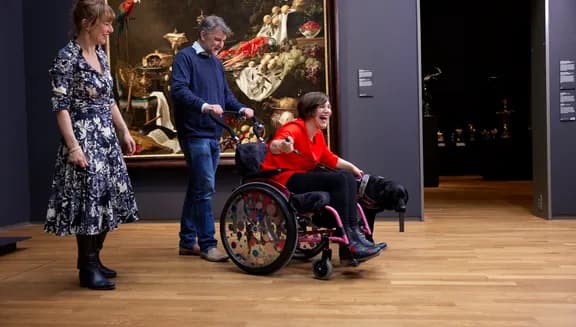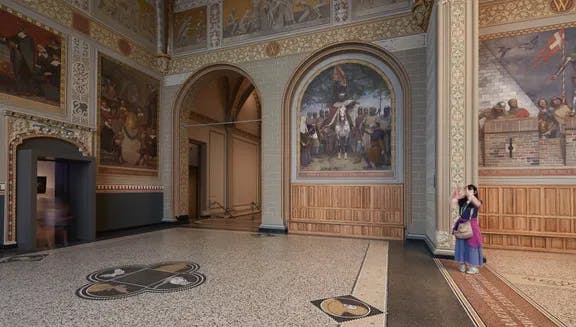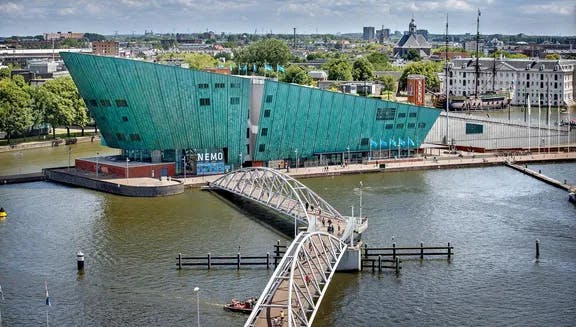
Art to touch: museums for blind and partially sighted visitors in Amsterdam
Museum Ons' Lieve Heer op Solder

“Together, you see more.” - With this idea, Museum Ons' Lieve Heer op Solder (Our Lord in the Attic) has developed an audio tour of the incredible historic canal house. Visitors can discover the museum through sound, smell and touch with a companion. If you prefer to come without a guide, you can also explore the museum in a small group on a guided tour for people with visual impairments. Upon entering, experience a large building model to understand the layout better. For independent visitors, there are walkways to the cloakroom and toilet. Assistance dogs are welcome, but please note that the building has steep stairs.
Rijksmuseum
At the Rijksmuseum, your experience begins with helpful staff who will notice you immediately. At the front desk, ask for the model, which allows you to feel the museum in miniature. By touching dolls in different rooms, you'll hear what there is to discover - a perfect start to your visit. Audio-assisted tours are available; for groups, there is the possibility of feeling images and objects. While this does not apply to the paintings, the audio support largely compensates for this. “One time, I was kindly tapped on the shoulder and even got a personal tour as a surprise!” says editor and experience expert Erik Loijenga.
ARCAM
Architecture for all should be the norm, according to ARCAM. They have a tactile model of the building and its surroundings, listenable exhibition texts, and adapted font sizes and paragraph spacing. Videos have subtitles. Besides the exhibitions, much has been done to make the building more accessible: stairs are marked, colour contrasts have been improved, glass doors have markings, bright lights can be tempered with curtains, and assistance dogs are welcome.
Luther Museum

Behind the doors of the Wittenburg building on Nieuwe Keizersgracht is the Luther Museum, an atmospheric space filled with large rooms and precious objects. Here, too, steps have been taken to make the museum accessible. Assistance dogs are welcome, and for those with visual impairments, an audio tour and a large-print book are available to help visitors absorb the information.
ARTIS-Groote Museum

The big questions of life take centre stage at the ARTIS-Groote Museum. How are we built, and what role do we play in the bigger picture? Explore the diversity of life on Earth - from microbes and plants to humans - with all your senses. In this interactive museum, you can feel, smell, hear and experience a lot. Walk through the scent tunnel and discover whether certain smells evoke memories, such as freshly cut grass, tree bark and toothpaste. With the audio tour, you can delve deeper into the exhibited themes. Ask at reception about accessibility options and obstacles to make your visit as enjoyable as possible.
Rembrandt House Museum
Upon entering Rembrandt House Museum, ask about the maquette created by Hannes Walraven, a blind photographer. This maquette, with dolls offering audio support, provides a rich experience. Scent stations also take you back in time for a complete experience. Erik says: “I collaborated on the museum audio tour to make it as accessible as possible - without being patronising.” When he visited the museum with his grandchildren, they were surprised by the playful aspects of the tour, which are especially engaging for children. “Highly recommended for everyone from people who are blind or visually impaired to families!”
NEMO
NEMO Science Museum is all about experience, with interactive installations encouraging you to feel, hear, smell and move freely. Many steps have already been taken in the field of visual accessibility. For instance, there is the eZwayZ app, which allows you to navigate the building independently. In addition, the lights have been adjusted, and the text has been enlarged and displayed in a more accessible font.
Tip: Before your visit, note a few points. The route to NEMO is not always safely accessible, so it is recommended that you take a companion with you. In addition, the app is currently only available for iPad and iPhone and does not yet work optimally on all floors. Ask at the front desk for the latest information before heading upstairs.
Amsterdam Pipe Museum
At the Amsterdam Pipe Museum on Prinsengracht, every visitor is given a guided tour to fully experience the remarkable stories behind the pipes. They will receive detailed explanations about the objects' material, decoration, and details. Especially for people with visual impairments, there is a collection of items they can feel, and time is taken to guide visitors through all of the fascinating objects.
Written by Erik Loijenga - Experience expert with a visual impairment and member of the Wmo Advisory Board who knows how Amsterdam culture can be accessible, diverse and inclusive.
Related articles

Art on wheels: wheelchair-accessible museums in Amsterdam

Art with your eyes and heart: museums for deaf and hard of hearing visitors in Amsterdam

Art at your own pace: low stimulus museums in Amsterdam

Wheelchair-friendly history museums in Amsterdam

Historic buildings in Amsterdam that are wheelchair-friendly

Wheelchair-friendly immersive experiences in Amsterdam

Accessible theatre and stage in Amsterdam

Wheelchair-friendly things to do in Amsterdam for kids

Wheelchair-accessible shopping tips for Amsterdam











